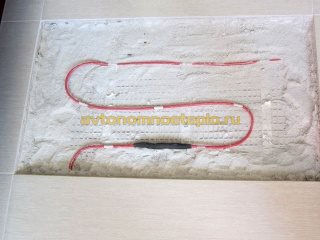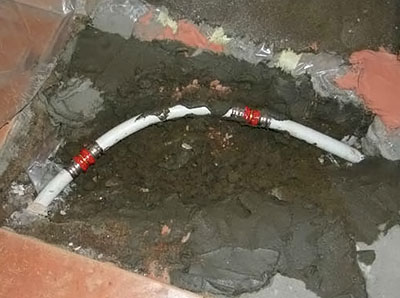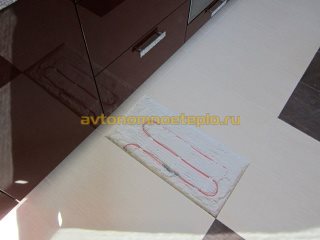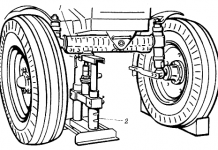In detail: DIY repair of a warm floor from a real master for the site my.housecope.com.
Basic information about repairing a warm floor (electric) with your own hands: what malfunctions there may be and how to repair them, as well as how to fix the system if the cable is broken.
Although warm electric floors have long ceased to be a luxury, but have become commonplace, many consumers are interested in how long it will last before buying and installing such a system.
Considering the cost of the structure itself, its installation and energy consumption during operation, such experiences are quite appropriate.
As the manufacturers promise, electric underfloor heating is a reliable heating system with a shelf life of 10 years, and this is confirmed by those who have been using them for a long time. It should be borne in mind that no matter how good an electric warm floor is, malfunctions can also appear in it.
The principle of operation of a warm electric floor is not much different from other types of electrical appliances. The current, falling on the heating element, heats it up, it gives up its heat to the screed or floor covering, thereby warming up the air in the room.
The passage of current to the heating system is carried out through a thermostat, the main function of which is to turn the floor on and off, and regulate the strength of its heating. As soon as it reaches the set temperature, the thermostat turns off, which also happens when the coating overheats.
What can cause a weak floor heating or a complete lack of heat?
Typically, the most common culprits are:
- Thermostat, so the check must start with it. To make sure of its malfunction, you should dismantle the device, turning off the light first, and check it with a multimeter.
- If the floor is cable, then breakage may become the cause of breakdown. This happens either during installation, or by some mechanical action, for example, with a drill during repairs. The cable is checked by measuring its resistance and insulation. If the data exceeds the readings of the data sheet by more than 5%, then it is damaged or there is a break in it. In the infrared system, rapid deterioration of the film is possible due to an insufficiently dense coating. If, for example, thin linoleum was put, then even a woman's heel can push through the film floor.
- The temperature sensor can also cause a malfunction. If the base does not warm up at full capacity, then it simply does not turn off and the floor works non-stop around the clock, which leads to high energy costs. On the other hand, if the temperature sensor is too close to the heating elements, then it will quickly heat up and turn off, and the floor will not reach the desired temperature.
| Video (click to play). |
Whatever the cause of the breakdown, the repair of an electric heated floor, if you have the necessary tools, can be done independently.
Read below how to fix an electric underfloor heating.
If the heating cable is the cause of the breakdown, then the steps for its detection and elimination are as follows:
- Disconnect the cable from the thermostat, and the entire system from the mains.
- A high-voltage generator must be available to locate the break. It will create an electric arc at the breakdown site.
- If there is no high voltage generator, you can use an audio detector, which will emit a sound at the place of the cable break like a metal detector.
- Voltage tester - this is the simplest and most effective way of checking, since it not only shows that there is a cable under the screed, but also the place where it was broken.
It is difficult and expensive to repair the cable, if an electric warm floor has been broken through, because it is under a layer of screed, then troubleshooting should be taken very seriously, starting with measuring the resistance of the heating element to an open circuit.
When a section with a gap is found, you need to:
- Remove the floor covering in this place.
- Break the screed carefully, trying not to get on the cable located under it, so as not to aggravate the situation with a breakdown. Repairs can only be started if a sufficient amount of cable has been released.
- When buying a ready-made set of a warm cable floor, the consumer receives the "little things" necessary for its repair - special heat-shrinkable sleeves and sleeves. It is enough to strip the wire at the breakage point, connect it with a sleeve, squeeze it with pliers, put a sleeve on the cable and warm it up with a hairdryer. Under hot air it will become smaller and the film will insulate the repaired area.
- Before the flooring is restored, the system is connected and checked for serviceability.
- A screed is made and the topcoat is put in place.
If the necessary tools are not available, it is cheaper to call the masters who will find the cause of the malfunction and fix it efficiently and quickly.
This part of the warm floor is the easiest to repair:
- Because the temperature sensor is installed in the corrugated tube, then it will not be difficult to find it.
- The device must be removed and replaced with a new one., then returning the tube with the sensor to its place.
- The good news is that even if a grouting cable system is used, the floor does not have to be opened, since part of the corrugated tube is in the wall. It is enough to get it out, pull the wire and the sensor will come out.
- In the reverse order, the new device is inserted into the tube, and then the groove in the wall is painted over and returned to its original appearance.
Terminals become a common cause of breakdown of the thermostat.that connect the power cord, cable, and temperature sensor. They can loosen and tighten them enough to make the floor work again. In the on state, the voltage in the power supply and at the terminals must match.
If this did not help, and the resistance measurement showed a large deviation from the technical indicators, then the thermostat must be replaced.
Those are the simplest ways to repair an electric heated floor with your own hands.
-
Content:
- How to find a broken floor heating cable
- How to repair a floor heating cable
- Electric floor repair equipment
A professionally installed electric underfloor heating works flawlessly in almost 100% of cases. Most often, problems are observed in cases where the cable was laid on its own. To repair a warm electric floor with your own hands, you will need to find the place where the cable breaks and repair the damage.
So that you do not have to tear off the entire screed with the inevitable repetition of the process of pouring the floors, you must try to determine where the cable is broken. It is quite difficult to find a break and even professional teams of installers do not always succeed, but using some advice and recommendations, you can increase the chances of success.

In particular, the following equipment is used:
- High-voltage generator - the device detects the location of a cable break by creating an arc between an unprotected conductor or wire braid. Damage is located at the place where the discharge occurs.
- Audio detector - the principle of operation of the device is similar to a metal detector. When the device is over the break, a corresponding sound is emitted.
- Voltage tester or hidden wiring detector. Cable integrity diagnostics are easiest to perform with this instrument. The wire detector not only shows the presence of a cable inside the tie, but also makes it possible with a high degree of probability to determine the location of the break.
The cause of a malfunction of the underfloor heating may be a break in the heating cable, failure of the thermostat or temperature sensor. In all these cases, you can repair the system yourself, the main thing is, first of all, to correctly determine the breakdown. Next, we will tell the readers of "Electrician Sam" how to repair an electric underfloor heating with your own hands!
If the electric underfloor heating does not turn on or does not heat up after turning on, the first step is to make sure that the heating cable is working. To do this, you need to measure the resistance of the cable with a multimeter. Ideally, the value should not differ from the passport by more than 5%. If you find a significant difference between the nominal and actual resistance, you need to move on to finding the open circuit and further repair. To do this, you can use special devices to find hidden wiring in the wall. In the place where the electrical circuit breaks, the device will immediately react.
As soon as the exact location of the malfunction is found, it is necessary to proceed to the repair of the electric underfloor heating with your own hands. All that is needed is to remove the floor covering at the site of the breakdown, carefully dismantle the section of the concrete screed (if any) and connect the problem area by pressing with a copper sleeve. After that, the cable junction is protected with a heat shrink tube and the system is checked for functionality.
We recommend that you immediately watch the video instructions for troubleshooting and repairing it yourself:
A situation may also arise that the electric underfloor heating does not heat up to the required temperature (set on the controller). One of the reasons for the breakdown is the weak contact of the wires in the terminal block of the thermostat. Check the screw connections and tighten if necessary as shown in the photo. Sometimes even a poor contact of the conductors can lead to such a simple type of electric floor heating repair that does not work. In addition, check the temperature sensor itself in order to make sure that the temperature controller is faulty by elimination. If all other elements of the circuit are in good working order, just replace the thermostat with a new one, because its cost is very small, and repairs can be quite a hassle.
We immediately draw your attention to the fact that the temperature controller can work and turn off the system early if the temperature sensor is incorrectly installed. If the sensor is located close to the heating cable (or far from it), the temperature readings inside the screed will differ by 2-3 degrees, which will cause a false alarm!
Checking the temperature sensor is also not difficult when repairing an electric underfloor heating. To do this, you again need to ring the device yourself with a multimeter to make sure that the passport and actual resistances match. If the temperature sensor breaks down, it must be replaced with a new one. If you followed the recommendations for laying the warm floor under the tiles and placed the temperature sensor in the corrugation, it will be quite easy to get it out from under the screed. Otherwise, if the sensor gets stuck under the floor, it is better not to touch it, but to solve the problem in a simpler way - by installing an air temperature sensor. This device will give a signal to turn on / off the thermostat based on the temperature in the room, and not under the screed, as it was before.
You can also do without repairs by purchasing a thermostat with a timer, which will turn on / off the system according to the setting. In addition, there are IR temperature sensors that analyze the heating of an electric underfloor heating by means of infrared radiation.
If you notice that the electric underfloor heating does not heat well at low voltage or its surges, then you can get out of the situation by installing a stabilizer for the home network.This device will ensure the normal operation of the heating system, both at low and high voltage.

That's all that I wanted to tell you about how to repair an electric floor heating with your own hands. As you can see, all the malfunctions are quite simple and no special knowledge of electrical engineering is required to solve the problem. At the same time, if you are too lazy to repair the system yourself, the master will take at least 5,000 rubles for this (the average cost of installing a coupling on the damaged section of the heating cable).
Also read:
The content of the article:
- Main varieties
- Underfloor heating repair
- Water
- Electric
- Infrared
- Prevention of breakdowns
Underfloor heating is a heating system located on the ceiling of the building. Often it serves as a full-fledged heating, which is especially typical for country houses. Carrying out uniform and comfortable heating of the room, the warm floor creates a favorable microclimate in it and maintains an optimal level of air humidity. But any technical device is capable of malfunctioning sooner or later, and a heated surface is no exception. You will learn from this material how to get out of this situation with dignity by performing a simple repair of a warm floor with your own hands.
To troubleshoot a warm floor, you should know its device. Thanks to the heating system built into the floor structure, the surface is transformed into a large panel that radiates heat. Its carriers in the system can be electrically conductive elements or pipes.
On this basis, four main types of warm floors are determined:
- Electric floors... They are cable, film, rod and have the same device, consisting of a heating element, a temperature sensor and a thermostat. An electric underfloor heating works in this way: when it is connected to the electrical network, the conductive elements are heated, and the temperature sensor monitors the temperature of the floor surface. When it is equal to the room temperature, the electrical power supply to the floor is cut off. When the room cools down, underfloor heating will automatically resume. The operation of the entire system is provided by a special thermostat, on the scale of which you can set the desired room temperature, which will be constantly maintained.
Water floors... They can be connected to both an autonomous heating system and a centralized one. The transportation of the coolant for water floors is carried out using pipes that are made of various materials: metal-plastic, cross-linked polyethylene, polybutane, copper or stainless steel. All of these pipes are corrosion resistant and durable. In addition to them, the set of equipment for the water floor includes mixing units and distribution manifolds. The first are designed to maintain a stable temperature of the carrier, the flow of hot water into the system and its circulation. The second distribute it along all the contours. The water floor works in this way: hot water comes from a centralized heating system or a gas boiler, which constantly circulates through the pipes of the system, built into the floor screed. Thanks to this, the heat from the floor rises up and is evenly distributed throughout the room.
Electric liquid floors... It is a symbiosis of both of the above systems, combining their advantages in their design. The heating element is a thick-walled tube with a diameter of 20 mm, made of structured polyethylene and filled with antifreeze coolant. Inside the pipe, along its entire length, a heating cable runs, consisting of threads of a chromium-nickel alloy, enclosed in a Teflon sheath. Pipes with coolant and cable are hermetically sealed. The coolant itself does not move, it is static.Therefore, the electric liquid floor does not need a manifold, boiler and pump. Otherwise, the scheme of work of such a floor is identical to that described above.
Let's consider in more detail the main breakdowns of underfloor heating and how to troubleshoot system malfunctions.
Its main malfunctions may be a coolant leak, a clogged filter, a breakdown of a circulation pump, or a consequence of installation errors. You need to start repairing a water-heated floor with its diagnosis.
First, you need to determine where the floor does not heat. If this happens in the same room, it is worth looking for the problem in the coil or collector in that room. When the floor does not heat up in all rooms, this means that the problem may be an insufficient water level, a faulty pump, a boiler or a clogged filter.
To check the level of the coolant in the system, you need to add water to it so that it begins to flow out of the drain pipe. After this procedure, the performance of the water floor improves in 20% of cases.
If underfloor heating does not work in only one room, you need to check the filter. To do this, unscrew it and inspect the cartridge carefully. Its contamination indicates that the elements of the system need to be flushed. Mud deposits make it difficult to transport water through the heating pipes.
A decrease in its pressure in half of the cases appears as a result of errors in the installation of the heating system. The inner diameter of the coil pipes is small - only 5-10 mm. Their wrong bending and clogging can lead to a malfunction of the warm floor. To check this yourself, you need to pump the system. If there is an air release valve, open it and wait until the water in the expansion tank pushes the air out. After the liquid flows from the tap, it must be closed and the system must be filled with water before it exits the drain pipe. If bleeding fails, this indicates obstruction of the floor coil pipes.
To check the circulation pump, you need to turn it on and listen to how it works, having previously released air from the system. A serviceable unit will hum monotonously without vibrations, knocks and other extraneous sounds. Otherwise, it is recommended to drain the water from the system, turn it off and take it for repair.
If there is a pressure gauge installed after the pump, you need to plug the return pipe, turn on the unit and check the pressure in the system using the device. It should have a value of 0.5 atmospheres or eight pascals. If the pressure is less, it indicates poor floor performance due to water leakage.
You can determine its place as follows: the pump should be turned on for a couple of hours and add water to the system. If there is no leakage, liquid will immediately begin to flow out of the drain connection. If this did not happen immediately, it will be necessary to pressurize each circuit separately and the entire system as a whole. After completing it, you can establish a section of water leakage, due to which the system does not heat up. Such a breakdown of a warm floor requires special equipment. If a water leak occurs in the pipe joint, it must be replaced, and eliminating the leak in the coil will require replacing the floor heating system in a separate room.
When unfiltered water is poured into the heating system, dirt enters the pipes along with it.The high temperature of the carrier leads to the appearance of silt plugs, which, by narrowing the lumen of the inner cavity of the pipes, reduce the quality of the heating system. If this happens, it will need to be flushed. It is better to entrust this work to specialists who can select the necessary reagents and correct the situation. If the warm water floor is operated correctly, flushing of its system will be required once every ten years, or even less often.
Its implementation requires from the performer basic concepts in electrical engineering, which will allow detecting and eliminating faults in electrical circuits. If knowledge is not available, it would be prudent to seek help in repairing underfloor heating at a service center.
The main malfunctions of the electric floor heating system can be a wire break or a heating element, burned contacts, breakdown of a temperature controller or sensor, as well as a short circuit of electrical circuits. The warm electric floor is designed so that each separate room is heated by one system. Therefore, a malfunction of the floor in any room indicates a breakdown of the heating control system in it or its heating elements and is absolutely not connected with the warm floors of the rest of the rooms.
When repairing a warm electric floor, checking its performance should begin with the control unit and sensor. To do this, use a voltmeter to measure the voltage at the terminals to which the power supply wires are connected. Then its value must be compared with the same parameter of the outlets in the neighboring room. If the voltage difference exceeds 10 volts, this indicates a poor-quality contact between the terminals of the control unit and the mains wires.
To fix this, turn off the power supply, remove the terminal screws, remove the wires and strip the ends. After that, the wires must be installed in their place and fixed with screws. If, after a subsequent check, the difference between the voltage indicators has not disappeared, it is worth looking for a problem in the supply wiring of an apartment, house or room.
Check the voltage value at the terminals of the heating element. When the relay is off, there should be no voltage. If the thermostat is set to the maximum temperature, the voltage at the terminals must be at least 210V. A reduced value indicates a poor-quality contact, a breakdown of a heating element or a faulty regulator.
The current value must correspond to the parameter specified in the technical passport of the thermostat. A clamp meter can be used to check. If the current is less, the problem lies in the regulator, which is repaired in a specialized workshop. In addition, the current can be reduced when the heating elements of warm infrared floors burn out or break.
The complete absence of current indicates a break in the wire suitable for the heating element. If the current value exceeds the rated value, the problem lies in the circuit closure. It can occur due to high humidity or errors in the installation of a warm floor. A short circuit is usually accompanied by overheating of the wires and the smell of their burnt insulation.
Such a floor consists of heating electrical elements connected in a parallel way. They are made of graphite and are located between special conductive tracks running on both sides of a special heating tape. Thanks to this design, the breakdown of one or two elements does not lead to the failure of the entire belt.
If the heating efficiency in any room has decreased, it is necessary to check the amperage consumed by the electric infrared floor. A deviation from its nominal value by more than 10% indicates damage to the warm floor in the form of a breakdown of several of its heating elements.
In this case, it is recommended to increase the floor heating temperature using the regulator, since the tape with conductive elements cannot be repaired. If necessary, it will have to be replaced.
To avoid damage to the warm floor, a number of nuances should be taken into account when installing it:
-
When calculating the size of the heating elements, you need to take into account the area of the room that is not occupied by furniture. This is due to the fact that underfloor heating elements are not recommended to be laid under bulky interior items due to the possible overheating of the system and its failure.
The purchase of floor heating elements should be carried out taking into account their required dimensions, since cutting the cables during installation can lead to damage to the system due to a decrease in its strength.
The heating cable should not be placed on a dirty subfloor. Before starting installation work, it must be thoroughly cleaned.
It is not recommended to walk on it during the installation of the warm floor in order to avoid damage to the heating elements with the hard sole of the shoe.
The temperature sensor should be installed so that during the repair of the thermostat, this part of the system is easily accessible. It is recommended to place the sensor in a corrugated tube.
There should be no voids around the heating element, they can cause the cable to overheat and fail.
In the process of installing a warm floor, it is recommended to make its diagram on paper with an indication of the dimensions. It may be required during repair work and will allow you not to touch the cable or pipe of the system when working with a cement screed.
The electrical resistance of the floor must correspond to its passport value specified in the documentation attached to the kit. Resistance measurements should be taken before and after the installation of the system.
Watch a video about underfloor heating repair:
Warm floors are available in many private houses and city apartments. Outside the city, water is usually installed. In urban conditions, this is problematic, often impossible in principle. Electricity is popular here: underfloor heating is the most efficient and economical electrical appliance. But it also tends to fail sometimes.
If another device breaks down, the problem is solved simply: you take it to the workshop.
The warm floor cannot be taken to the workshop. Either call the master at home, or repair the electric floor heating with your own hands.

Heating cable. There are two types of this floor: a coil with a wire, which, when laid, is sequentially unwound along the surface of the base, or mats - the cable is already unwound and fixed on the substrate, during installation, the mats themselves are laid and connected to the thermostat.
In the first case, before the finishing coating, the floor is covered with a screed. In the second, the screed device is optional.
Infrared heating element. There are also two types: a film in which thin carbon plates are embedded, and mats with carbon rods. Both can be installed without a screed from above. The core floor is considered to be more durable, but it is more expensive.
Any floor consists of the following components:
- heating element (see above);
- thermostat (the main unit for controlling the activity of the device);
- thermal sensor - a sensitive device placed together with a heating element under a screed or covering. It monitors the state of the system and transmits data to the thermostat.
We wrote about this in more detail in the article How to choose a warm electric floor.

If the system does not have a power reserve, voltage stabilizers can be used to normalize heating.
In most cases, the reason that the floor has ceased to function is the failure of one or more of the main elements.

For diagnostics, it is necessary to remove the topcoat, disconnect the system from the mains, disconnect the cable from the thermostat. Measure the resistance of the cable itself and the insulation (between the braid and the core), check with the values indicated in the data sheet. The margin of error is 5 percent maximum.
The break point is searched for with the help of devices - an audio detector (it functions on the same principles as a metal detector) or a high-voltage generator.
Thermoplates are sometimes used to identify the point of damage. When the voltage is low, sections of the cable become hot. By successively applying the plates, you can find a break.
Since mechanical damage is a common cause of breakage, first of all pay attention to those places where the screed is damaged. These sections must be opened and repaired in any case: if there is no cable breakage there, then there will certainly be.

After dismantling the coating on the faulty area, diagnostics are performed in the same way as for the cable floor: you need to disconnect the system from the network, disconnect the wires from the thermostat, measure the resistance at the contacts.
It is impossible to restore a damaged section, only to replace it as a whole.
If the entire film floor or all the mats ceased to function at the same time, the reason is most likely not in the film or in the mats, but in the thermostat or sensor.

- Check the fixation of the connecting terminals from the sensor, cable, mains wire.
- With the thermostat on, check the voltage of the cable at the output and input. It should be the same as the supply voltage.
- Measure the resistance of the sensor, compare with the passport data.
If the thermostat is indeed defective, then it must be replaced. But the problem may not be in himself, but in installation flaws: if the temperature sensor is incorrectly installed, it transmits incorrect temperature data to the thermostat.
As a result, the thermostat turns off the floor not in accordance with the settings, but in accordance with these incorrect data.

Those. the floor does not function according to the settings, but constantly, which leads to waste of energy.
To check the serviceability, the sensor must be disconnected from the regulator, measure its voltage and compare with the passport one.

The composition of the pie must include:
- waterproofing film;
- insulation;
- heat-reflecting elements.
In the absence of at least one of these components, the floor will be ineffective. There is only one way to fix this: dismantle the floor and lay it in accordance with the technology.
Otherwise, either the floor will not heat well, or the energy will be wasted. some of the heat will go down, not up.

Isolate the damaged area with a heat shrink sleeve. To do this, the coupling must be heated with a construction hairdryer. When it cools, it will shrink, the connection will be strong.
After the cable is restored, the destroyed section of the screed is poured with concrete and the topcoat is restored.

If replacement is not possible (there is a bend in the tube, the sensor is located in the screed), one of the options for restoring the system's performance is to replace the thermostat with a model with a timer.
In this case, the switching on / off of the floor will not occur depending on the temperature readings, but at fixed time intervals.

- Correct calculation of floor power.
- The cable must be suitable for the size of the room: when it is cut, the strength decreases.
- And / to the film can only be cut according to special markings.
- Cable mats do not cut at all, they must be selected immediately in accordance with the installation scheme.
- Competent thermal insulation.
- The floor is not placed under stationary furniture and household appliances in order to avoid overheating.
- Careful during installation: do not step on the heating elements.
- The sensor is placed in a protective corrugated tube.
- Before installing the screed or topcoat, the system must be tested.
- Until the screed is fully set, the floor cannot be turned on.

If there is no experience and self-confidence, it is better to entrust the choice and installation of the floor to a specialist.
If the selection and installation were carried out correctly, the cause of the malfunction is the failure of one of the working elements. Diagnostics is carried out depending on the symptomatology of the damage. In most cases, the problem is solved on its own.
Video about the repair of an electric underfloor heating.
The modern "warm floor" system has taken its place in many houses and apartments. Sometimes it happens that the "warm floor" system stops working, and this is when the coming cold months are on the doorstep. What should you do under these circumstances? Of course, you can solve the problem radically and completely replace the underfloor heating. True, a whole range of work will have to be carried out: tiled dismantling, screed construction and, finally, laying a new electric floor.
Underfloor heating is an electrical system installed in the floor, the wires of which are located under the screed or tiled structure. So, the surface of the floor appears to be a kind of large-sized panel, along which the heat dissipates in a uniform manner.
Electricity is supplied through a cable, which heats up at the same time and gives off heat to the floor. Before supplying electricity to the heating mechanism through a temperature regulator, with the help of which the heated floor is switched on and off from the current. Also, it helps to set the desired temperature in the floor surface and makes the underfloor heating forcibly turn off if the thermostat is too hot, which allows you to avoid malfunctioning of the device in the future.
A floor with a heating function is considered to be one of the most convenient ways to create even heat in a room. Many owners of such a system have already appreciated this method of heating their homes. The advantages also include saving space in the room, the required air temperature at the level of the baseboards, the absence of radiators, which often have an unaesthetic appearance.
The presence of such a convenient and new-tech device in the house often brings a sufficient number of worries and troublesome matters into the life of the owners. Another story begins when problems arise with the underfloor heating.
In order to repair a warm floor, it is necessary to identify the reasons that led to its malfunction.Competent and professional specialists divide the breakdowns of the “warm floor” system into three main categories.
In a situation where do-it-yourself repair of a warm floor is required, it often does not entail complex approaches to diagnosing the cause of the breakdown. A hot wire can burn out for simple reasons. Either the residents of the house themselves were to blame, or the installation technology was initially violated during installation, which was not revealed in a timely manner.
When repair work was carried out in the apartment before the breakdown using a drill, perforator or saw, the cable can be accidentally damaged, for example, if it was carefully hidden in the place of the desired hole. When the damaged wires have been found, you can start repairing the “warm floor” system yourself, replacing the damaged cable with a new one.
To fix such damage, you will need to open the screed itself. The damaged wire is stripped by attaching sleeves of the appropriate size in diameter and crimped with clamping pliers. The joint is fixed with a heat-shrinkable sleeve, which is preheated with a construction hairdryer and allowed to cool down. This is necessary so that the connection is compressed and sealed as much as possible. The place of restoration of the cable for repairing the warm floor is filled with cement mortar.
A failed temperature sensor will still enable the base to work as usual, just not using all its power. Its automatic shutdown will not be performed, and the power consumption will be consumed as much as possible. Attempts to reduce the temperature of the base itself will give nothing.
The problem with the sensor is solved by completely replacing it. Since the sensor is mounted in a special pipe with a corrugated structure during installation, the walls and base will not need to be opened. It is necessary to fix the position of the faulty sensor in the pipe and insert a new device in its place.
Installing the sensor in a screed without mounting it in a corrugated pipe is a violation of the technological process. In the case when the device is installed in the base, that is, it is necessary to insert another sensor under the temperature regulator. Here, the regulation of the sensor is due to the movement of air around the perimeter of the room, and not by the internal capabilities of the entire system. The temperature controller also needs to be replaced with a new device. Also read: underfloor heating on the balcony.
The operation of a warm water floor, subject to all installation rules, will be about fifty years. The guarantee of such flawless long-term work is the use of solid high-quality pipes in the installation. In the event that the pipe was damaged as a result of the work of a grinder or a hammer drill, it is necessary to immediately repair the water heated floor. The main requirement is to immediately turn off the water without removing the nozzle from the hammer drill or grinder.
To repair a warm floor, you will need two fittings holders, a piece of pipe and a press. The place near the pipe break must be pre-cleaned, providing unhindered access to the pipe. It is necessary to insulate the ends of the hose with special tape so that dirt does not get into the pipeline stream. You can wear latex gloves on the ends. The final part of the prepared pipe will need to be inserted into the fastener at the end of the section to be repaired. It is required to cut off the excess from the piece of the inserted pipe and connect it to the second end of the pipeline. Then it is necessary to subject it to pressing.
To check the correctness of the measures taken, it is enough to open access to water. If there are no obvious problems, the repaired area should be filled with a screed.
In cases where the diagnosis of a breakdown presents certain difficulties, you need to measure the voltage in the network. Normal operating voltage is usually indicated on the data sheet.Measurement data should not deviate from the prescribed indicators by more than 5%. It is also necessary to look at the indicator sensor for switching on the mechanism. If the indicator light is off, the voltage should be measured at the terminals as well. If there is no voltage, then this is direct evidence of a malfunction of the thermostat or the sensor itself. Also, the contacts on the temperature controller may be faulty. Then the external temperature indicator sensor must be checked. Try to disconnect it from the thermostat and measure the resistance. Its indicators should range from 5 to 30 kOhm. The instruction will allow you to determine the required indicators.
Turn off the heating cable when checking the thermostat. If no malfunctions in the sensor and temperature regulator have been identified, then the real reason in the absence of heat must be sought in the heating mechanism of the system. To do this, you need to measure the resistance of the insulation and the wire, and then make a reconciliation of the indicators in accordance with the instructions. A low insulation resistance indicates a break in the heating wire cable, as well as the need to repair the underfloor heating. Only special equipment and devices are able to accurately determine the required location of damage.
In order to avoid breakdowns of a different nature, correct installation must be carried out. In order to properly install a warm floor, you need to take into account a few points.
- The length of the heating mechanism must be taken into account with the free area, as the heating cable is not run under the furniture. This can create the possibility of damage to it.
- At the time of laying the floor, the heating cable must lie freely, there is no need to walk on it.
- The surface where the cable is laid must be clean. Everything must be cleaned beforehand.
- The heating element must correspond to the required parameter, since during installation, cutting the cable can lead to breakdown of the entire system. At the same time, its strength decreases.
- The temperature sensor should be built in so that at the time of a probable repair, access to it is free.
- It is unacceptable to leave voids near the heating mechanism, which usually provokes its failure.
- A sketch diagram should be made indicating the dimensions, which will help in the future in the installation work to avoid its involuntary damage.
After the floor has been laid, the resistance should be measured, which is important before and after installing the underfloor heating system. To bring the system into action, you must wait until the screed is completely dry.
It must be remembered that it is better to do the whole range of measures to prevent possible problems, than to eliminate the consequences of negligence at work later. Correctly carried out installation work guarantees a long service life of the warm floor.
| Video (click to play). |
Recommended reading: warm floor from heating.

















